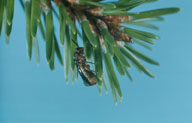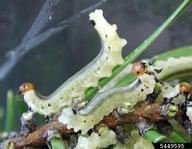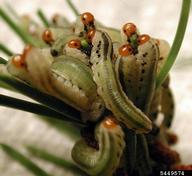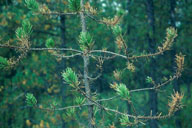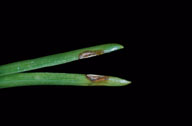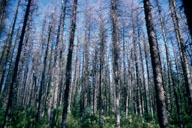Swaine jack pine sawfly
Neodiprion swainei (Middleton) (Hymenoptera: Diprionidae)
Orientation to pest
Swaine jack pine sawfly, Neodiprion swainei (Middleton), is a native North American sawfly. It is considered to be the most important sawfly pest of pines in eastern Canada. Its preferred host is jack pine (Pinus banksiana Lambert), but other species of pines will also be defoliated if they grow near an outbreak of this sawfly on jack pine. This sawfly is found in the Great Lakes states of the United States and throughout most of the range of jack pine in Canada (from Nova Scotia west to Alberta). Outbreaks though, have only been recorded in Ontario and Quebec. Swaine jack pine sawfly overwinters as a prepupa in cocoons in the liter or topsoil. Pupation occurs in spring and adults emerge soon after. In June or July, females lay one to three eggs per needle in the current year's growth. The larvae feed gregariously on old needles, usually on trees in exposed locations. Mature larvae drop from foliage to the ground, where they spin a cocoon in the duff and molt to the pre-pupa, the overwintering stage. There is one generation per year. Many outbreaks of this sawfly occurred in Ontario and Quebec up until the 1960s, usually at about 8 year intervals, on poor sites (for jack pine) on outwash plains. The last significant defoliation (in Canada) occurred over 440 ha in Quebec in 1994, In stands of mature trees, most trees may either be killed or, if they survive, will be stag-headed (killed on top). In the Lake states (USA), outbreaks have occurred mainly in plantations or windbreaks. A nuclear polyhedrosis virus that is specific to this sawfly was discovered in the 1960s and developed as a potential biopesticide. It provided effective control but was never developed as a commercial pesticide.
Hosts commonly attacked
The main host of the Swaine jack pine sawfly is jack pine (Pinus banksiana Lambert), but other pines that may be defoliated if near an outbreak of this sawfly include red (Pinus resinosa Sol. ex Aiton), eastern white (Pinus strobus L.), and Scotch (Pinus sylvestris L.) pines.
Distribution
This sawfly is found in Canada from Nova Scotia west to Alberta and in the Great Lakes states of the United States.
Images of Swaine jack pine sawfly
| Figure 1. Adult Swaine jack pine sawfly, Neodiprion swainei | Figure 4. Damage to jack pine by Swaine jack pine sawfly | |
| Figure 2. Eggs of swaine jack pine sawfly | Figure 3. Larvae of swaine jack pine sawfly | Figure 5. Jack pines defoliated by Swaine jack pine sawfly |
Important biological control agents related to this pest species
Important natural enemies of this sawfly include a nuclear polyhedrosis virus and various larval parasitoids. Red wood ants (Formicidae) were also introduced from Manitoba and Italy into Quebec as pupal predators.
Web links for information on Swaine jack pine sawfly
Articles
- Smirnoff , W. A. 1961. Predators of larvae of Neodiprion swainei Midd. (Hymenoptera: Tenthredinidae). The Canadian Entomologist 93: 272-275.
- Smirnoff, W. A., J. J. Fettes, and W. Haliburton. 1962. A virus disease of Swaine's jack pine sawfly, Neodiprion swainei Midd. sprayed from an aircraft. The Canadian Entomologist 94: 477-486.
- McLeod, J. M. 1970. The epidemiology of the Swaine jack-pine sawfly, Neodiprion swainei Midd. The Forestry Chronicle April issue, pp. 126-130- viewable at http://pubs.cif-ifc.org/doi/pdf/10.5558/tfc46126-2 provides details of timing and stand location where outbreaks have occurred in Quebec.
- Price, P. W. and H. A. Tripp, H. A. 1972. Activity patterns of parasitoids on the Swaine jack pine sawfly, Neodiprion swainei (Hymenoptera: Diprionidae), and parasitoid impact on the host. The Canadian Entomologist 104: 1003-1016.
- Price, P. W., R. H. MacArthur, and E. O. Wilson. 1973. Parasitoid strategies and community organization. Environmental Entomology 2: 623-626.
- Finnegan, R. J. and W. A. Smirnoff. 1984. Neodiprion swainei (Middleton), Swaine jack pine sawfly (Hymenoptera: Diprionidae), pp. 341-348. In: Kelleher, J. S. and M.A. Hulme (eds.). Biological Control Programmes against Insects and Weeds in Canada 1969-1980. Commonwealth Agricultural Bureaux, Slough, United Kingdom.
